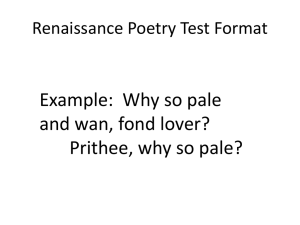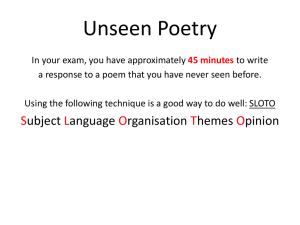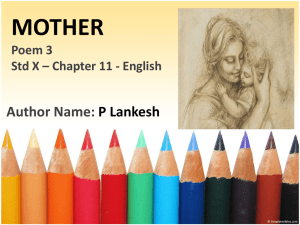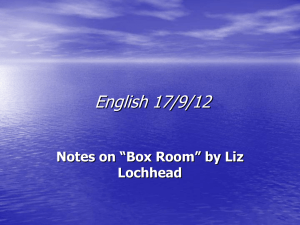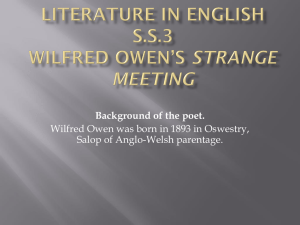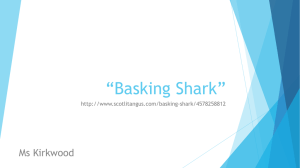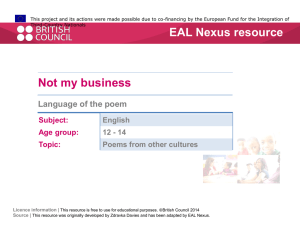Visiting Hour - missgrantenglish
advertisement
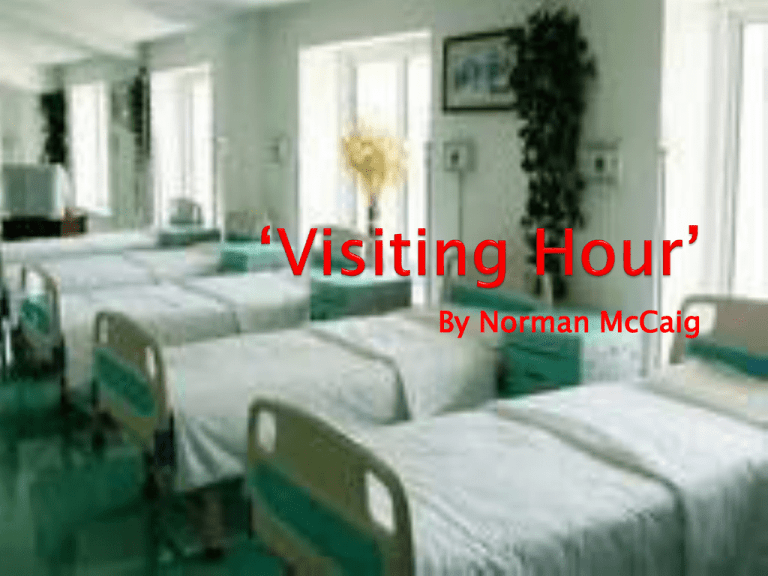
By Norman McCaig To become familiar with poetic techniques you will need to identify in ‘Visiting Hour’ To begin to analyse key poetic techniques at Higher level To identify the key themes and central concerns of ‘Visiting Hour’ On your own, read over ‘Visiting Hour’ and begin to form your first impressions. As a group, fill out your I See, I Think, I Wonder sheets. I See = write down what you can see in the poem. For example: different poetic techniques etc. I Think = write down what you think is happening in the poem. For example: what is being described? Who do you think the speaker is? What emotions does this poem describe? Etc. I Wonder = write down any questions you have about the poem. Is there something you don’t understand? What issues does this poem raise in you? The poet is visiting a dying friend or relative in hospital, and tries to avoid his emotions on his way to the ward. When he arrives, he is overcome by grief and anguish, and leaves the visit feeling it has been pointless. What is a theme? What a speech, piece of writing, or artistic work is about An implicit or recurrent idea; a motif A salient abstract idea that emerges from a literary work's treatment of its subject‐matter; or a topic recurring in a number of literary works. While the subject of a work is described concretely in terms of its action (e.g. ‘the adventures of a newcomer in the big city’), its theme or themes will be described in more abstract terms (e.g. love, war, revenge, betrayal, fate, etc.). Facing Death (either the dying person, or the relative) Isolation surrounding death/emotion At Higher, you must be able to identify and analyse a range of poetic techniques. These may be unfamiliar to you but you will need to know these for your Textual Analysis NAB and critical essays. In groups, try to match the different techniques with examples from the poem. A part is used for the whole or a whole for the part e.g. hired hands for workmen. A figure of speech in which an implied comparison is made between two unlike things that actually have something in common. The description of one kind of sensation in terms of another condition in which one type of stimulation evokes the sensation of another, as when the hearing of a sound produces the visualization of a colour. A sensation felt in one part of the body as a result of stimulus applied to another, as in referred pain. The description of one kind of sense impression by using words that normally describe another. The running on of the thought from one line, couplet, or stanza to the next without a syntactical break. Emotive words the writer has chosen on purpose due to their connotations. The repetition of a particular word or phrase to add emphasis. Grammatical arrangement of words. A complete stop in a line of poetry. A grammatical pause or break in a line of poetry (like a question mark), usually near the middle of the line. A figure of speech that combines contradictory terms. E.g. old news, open secret. A simile is a figure of speech that directly compares two different things, usually by employing the words "like", "as", To compare two things that are different to highlight their opposition. In your groups, try to match the ten poetic techniques with examples in the poem. Be prepared to report back your ideas and self assess. A part is used for the whole or a whole for the part e.g. hired hands for workmen. “… nostrils/ as they go bobbing along” Synecdoche is used, since not just his nostrils are moving along, as the image would suggest. This emphasises the overpowering nature of “the hospital smell”, since it has blocked out his other senses. A figure of speech in which an implied comparison is made between two unlike things that actually have something in common. Lots of examples within the poem! “white cave of forgetfulness”, “withered hand/ trembles on its stalk”, “glass fang” etc. The description of one kind of sensation in terms of another condition in which one type of stimulation evokes the sensation of another, as when the hearing of a sound produces the visualization of a colour. A sensation felt in one part of the body as a result of stimulus applied to another, as in referred pain. The description of one kind of sense impression by using words that normally describe another. “the round swimming waves of a bell” – Synaesthesia, as a visual image describes a sound (signalling the end of the Visiting Hour?). “swimming” could suggest the poet’s dizziness (confusion) or tears. This is from the woman’s point of view, so further shows her isolation, and the poet’s isolation from her The running on of the thought from one line, couplet, or stanza to the next without a syntactical break. “What seems a corpse/ is trundled into a lift and vanishes/ heavenward” – Enjambment is used here to emphasise the last words of the lines, carefully chosen to suggest a finality in death; “corpse” containing very little connotation of life, and “vanishes” further stressing the poet’s view that death is absolute. “heavenward” therefore seems incongruous, although this is simply an example of MacCaig trying to avoid the seriousness of the visit by creating whimsical images. Emotive words the writer has chosen on purpose due to their connotations. Again, lots of examples within the poem e.g. “combs my nostrils”, “corpse”, “miraculously” etc. The repetition of a particular word or phrase to add emphasis. “so much pain, so/ many deaths …/ so many farewells” – Repetition of “so” stresses the frequency of the nurses’ unpleasant dealings, which supports the high esteem, perhaps envy, with which he regards the ability of the nurses to cope. Grammatical arrangement of words. “here and up and down and there” – the unusual syntax (word order) is another example of the poet trying to lighten the mood, while also emphasising the number of nurses he sees. It suggests MacCaig is looking all around to find a distraction from his thoughts. Complete stop in a line of poetry A grammatical pause or break in a line of poetry (like a question mark), usually near the middle of the line “Ward 7.” – The abruptness of this non-sentence jolts the reader, just as we can imagine it affected MacCaig; this effect is heightened by the caesura it causes. This is the turning point of the poem, as he has now reached his relative and must face his emotions. A figure of speech that combines contradictory terms. E.g. old news, open secret. “fruitless fruits” – the final words are an oxymoron: how can a fruit be fruitless? This captures the poet’s despair at the pointlessness of the woman’s death being prolonged, and his inability to help – bringing fruit has been “fruitless”, i.e. pointless. To compare two things that are different to highlight their opposition. “Nurses walk lightly, swiftly/here and up and down and there,/their slender waits miraculously/carrying their burden/of so much pain.” – Nurses seem delicate/care free in contrast to their “heavy” burden of dealing with emotional weight of grief and death. A simile is a figure of speech that directly compares two different things, usually by employing the words "like", "as", “What seems like a corpse/is trundled into a life…” – speaker clearly preoccupied with death and interprets patient in a negative way. On your exit card, write down the technique you feel most confident in identifying and the technique you feel least confident with.



